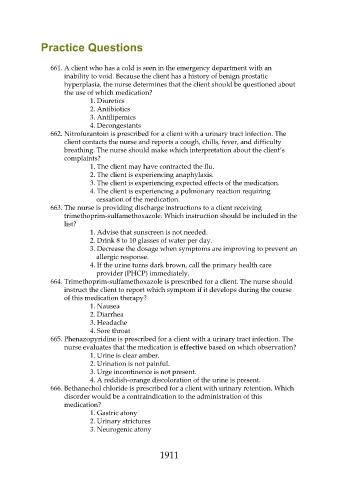Page 1911 - Saunders Comprehensive Review For NCLEX-RN
P. 1911
Practice Questions
661. A client who has a cold is seen in the emergency department with an
inability to void. Because the client has a history of benign prostatic
hyperplasia, the nurse determines that the client should be questioned about
the use of which medication?
1. Diuretics
2. Antibiotics
3. Antilipemics
4. Decongestants
662. Nitrofurantoin is prescribed for a client with a urinary tract infection. The
client contacts the nurse and reports a cough, chills, fever, and difficulty
breathing. The nurse should make which interpretation about the client’s
complaints?
1. The client may have contracted the flu.
2. The client is experiencing anaphylaxis.
3. The client is experiencing expected effects of the medication.
4. The client is experiencing a pulmonary reaction requiring
cessation of the medication.
663. The nurse is providing discharge instructions to a client receiving
trimethoprim-sulfamethoxazole. Which instruction should be included in the
list?
1. Advise that sunscreen is not needed.
2. Drink 8 to 10 glasses of water per day.
3. Decrease the dosage when symptoms are improving to prevent an
allergic response.
4. If the urine turns dark brown, call the primary health care
provider (PHCP) immediately.
664. Trimethoprim-sulfamethoxazole is prescribed for a client. The nurse should
instruct the client to report which symptom if it develops during the course
of this medication therapy?
1. Nausea
2. Diarrhea
3. Headache
4. Sore throat
665. Phenazopyridine is prescribed for a client with a urinary tract infection. The
nurse evaluates that the medication is effective based on which observation?
1. Urine is clear amber.
2. Urination is not painful.
3. Urge incontinence is not present.
4. A reddish-orange discoloration of the urine is present.
666. Bethanechol chloride is prescribed for a client with urinary retention. Which
disorder would be a contraindication to the administration of this
medication?
1. Gastric atony
2. Urinary strictures
3. Neurogenic atony
1911

